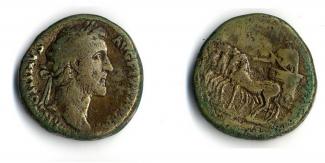Coin, Roman, bronze, excavated at St George's Street, Winchester, Hampshire, issued by Antoninus Pius, 138 to 161.
Brass 'sestertius' of the emperor Antoninus Pius
Roman, AD138-161
From an archaeological excavation at St George's Street, Winchester, Hampshire
Before the conquest in AD43 most of Britain had no substantial bronze coinage so everyday purchases were presumably conducted by barter rather than coin. After the invasion bronze (ie orichalcum and copper) was brought in though it is hard to estimate the extent to which Britain had a full monetary economy, using coins to the extent we do in modern society. The range of coins - aureus, denarius, sestertius and as - was sufficient for transactions of all sizes. This sestertius would have bought a couple of loaves of bread or a few litres of wine.



